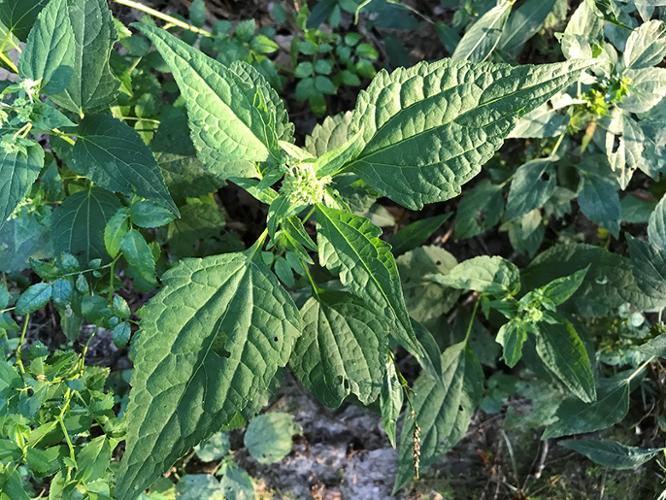Picture of the Week
November 30, 2020
White Snakeroot (Ageratina altissima)
Marcelo Zimmer, Weed Science Program Specialist, Purdue University
If you are a pasture owner then you should keep an eye out for white snakeroot (Figure 1), especially if you have wooded and/or shaded areas accessible to your grazing animals. White snakeroot is a toxic plant. This native perennial is toxic to cattle, horses, goats, sheep, and swine if they eat the plants[1]. Owners of nursing animals and dairy animals should be extra vigilant in making sure that their animals are not feeding on white snakeroot, due to the fact that the toxins are transferred into the milk.
It is believed that Abraham Lincoln's mother died of "milk sickness", a condition from drinking milk from animals that fed on white snakeroot. Today, "milk sickness" is uncommon due to better understanding of what causes it and its avoidance, and due to the practice of mixing milk from several cows. It is recommended that animals be removed from pastures infested with white snakeroot by midsummer.
Symptoms observed in animals that have fed on white snakeroot include listlessness, constipation, and violent trembling. The animal's breath will often smell like acetone. Vomiting, teeth grinding, and weight loss are common. Often animals fall and will not get back up again. Horses don't usually develop the trembling but become sluggish and appear to loose some muscle coordination. In some cases a horse's throat muscles become paralyzed, making it unable to swallow.
White snakeroot is native to Indiana. It is a slightly hairy perennial herb that grows up to 4 feet tall. The leaves are opposite, simple, and coarsely toothed along the margins. Leaf width can be 2 to 7 inches long and 1 to 5 inches wide. The floral inflorescence is made of loosely branched corymbs that originate from leaf axils of the upper leaves. White snakeroot's white flowers will bloom from mid-summer to the fall (July to October).
Control of white snakeroot can be difficult, depending on its surroundings. The herbicides that are effective on white snakeroot will also damage desired trees or seeded legumes. If there are few plants, hand-pulling may be a viable option. If hand-pulling white snakeroot, pulling after a rain or when the soil is moist will make the process easier.
In a grass pasture, a dicamba containing product (Banvel, Clarity, others) may be most effective and can be used at 1 to 6 qt/A (4 lb ai/gal product). Both Crossbow (triclopyr + 2,4-D) and glyphosate containing products (Roundup PowerMax, others) have been reported to have good activity[2]. Using 2,4-D or Stinger is not as effective as the use of the above herbicides. Oust Extra is labeled for the control of white snakeroot at 3 to 4 oz/A in fence rows, noncrop areas, CRP, and in certain forestry situations (see label for details).
Reference:
- McCain JW, Goetz RJ, and Jordan TN (1985) Indiana Plants Poisonous to Livestock and Pets (WS-9). Cooperative Extension Service, Purdue University.
- Loux MM, Doohan D, Dobbels AF, Johnson WG, Young BG, Zimmer M, Hager A (2020) 2020 Weed Control Guide for Ohio, Indiana, and Illinois. [WS-16 p. 182]
Click image to enlarge
Figure 1. White snakeroot plant flowering (Photo: Glenn Nice)
Close up photos by Keith Johnson




